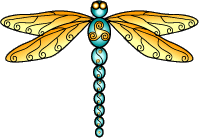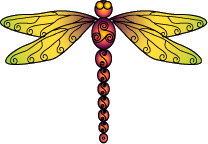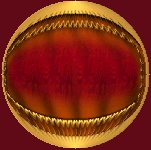Dragonflies: Bridging Air and Water (c) Cheryl Lynne Bradley 2006

For as long as I can remember I have always been fascinated with Dragonflies. I often wonder if it hasn't always been coming from a subconscious level. I am an Air/Water cusp in my astrology and my struggle is always to build the bridge between my intellect and my emotions and in expressing the things that are written on my heart. The dragonfly is closely tied with both of the elements of Air and Water and lives its life balancing between the two. Dragonflies are seen as a symbol of the sense of self that we develop as we mature. They are also viewed as being both spiritual and magical with the power to bring harmony and prosperity. The dragonfly wants us to seek out the parts of ourself which need to heal.
Anyone who is a resident of Ontario is familiar with the mosquito fighting practice of dumping large quantities of dragonflies over the country side to consume and control the mosquito population. Dragonflies, or Anisoptera, are a suborder of an order of insects called Odonata. They are relatively easy to distinguish from other orders of insects: the adults have a pair of prominent compound eyes which dominate the head; they have a contracted thorax which supports three pairs of legs, two pairs of delicate and membranous wings, as well as a long, slender abdomen. Dragonflies breathe through spiracles (holes) in the abdomen. During the larval stage they live in water and breathe through gills. At all stages of their lives, dragonflies have enormous appetites and feed on small animal matter. They cannot sting and they cannot harm us in any other way. The dragonfly is also a dazzling and artful flier - moving back and forth between air and water with ease, grace, speed and agility.
Dragonflies come in an assortment of beautiful, vibrant colours and their life span can vary dependent on the area in which they live. Their outer shell is designed with special facets which reflect and refract the light of the sun. The Dragonfly is one of the oldest living creatures that we still have with us. Fossil records show us recognizable remains of the ancestors of our modern Dragonflies. These fossils date back to Carboniferous times and that means that these insects were here more than 300 million years ago. They predate dinosaurs by 100 million years and birds by 150 million years. Dragonflies are found all over our world, in temperate, desert, tropical and subtropical zones - they share their beauty (and appetite for mosquitos and gnats) with us all. This longevity is a testament to their adaptability and instinct for survival as a species.

The Dragon-fly by Alfred Lord Tennyson
Today I saw the dragon-fly
Come from the wells where he did lie.
An inner impulse rent the veil
Of his old husk: from head to tail
Came out clear plates of sapphire mail.
He dried his wings: like gauze they grew;
Thro' crofts and pastures wet with dew
A living flash of light he flew.
There are a few superstitions about dragonflies. One old one claims that anyone who catches a dragonfly will marry within a year. A fisherman with a good heart can tell from the position of a dragonfly where the good fish are. If he isn't of good character they will lead him astray by hovering over empty water. Dreaming about a dragonfly landing on you means you will hear excellent news from someone far away. A dead dragonfly symbolizes sad news.
In ancient Tahiti, dragonflies were regarded as mysterious agents of the gods and spirits - both good and bad.. The dragonfly was the shadow of Hiro, who was the god of thieves. Hiro flew and halted before and behind.Thieves carried them in their clothes so that when they entered the dwelling of those they wished to rob and they let the dragonfly go, it would dazzle the inhabitants into not knowing that they were being robbed. To Native Americans the dragonfly represented the whirlwind as well as swiftness and activity. In China, the dragonfly represented Summer but also represented instability and weakness.
In Japan they represented irresponsibility and unreliability. The dragonfly, now called "tombo" in Japanese, used to be called "akitsu". Japan was once called Akitsushima meaning "The Island of the Dragon-fly". The Japanese also believed that tracing a certain ideograph in the air would paralyze a dragonfly in order that you could catch it. The Samurai considered the dragonfly as katsumushi or the "invincible insect" and it was a favourite symbol for strength used by these warriors as adornment on their helmets and armour. In both China and Japan, dragonflies were a popular seasonal theme and often a topic for Haiku poetry.
To the Zuni Indians of the pueblos of the American southwest, the dragonfly was shamanistic and had supernatural powers. There is also a tale traditional to the Zuni called "The Boy Who Made Dragonfly". In this story, two small children fell asleep and were accidentally left behind when their parents and the rest of the villagers abandoned their village. Things were difficult and food was scarce so they had all gone to try and find food. The young boy constructs a toy insect out of corn and grasses to comfort his younger sister. Eventually, the toy comes to life and operates as a messenger between the children and the gods. The insect later takes the name Dragonfly.
The story of the metamorphosis of the dragonfly is used in myth and fable commonly as an explanation for the passage through death of a loved one. Two slightly different versions of these tales follow:
The Dragonfly
Once, in a little pond, in the muddy water under the lily pads, there lived a little water beetle in a community of water beetles. They lived a simple and comfortable life in the pond with few disturbances and interruptions. Once in a while, sadness would come to the community when one of their fellow beetles would climb the stem of a lily pad and would never be seen again. They knew when this happened; their friend was dead, gone forever.
Then, one day, one little water beetle felt an irresistible urge to climb up that stem. However, he was determined that he would not leave forever. He would come back and tell his friends what he had found at the top. When he reached the top and climbed out of the water onto the surface of the lily pad, he was so tired, and the sun felt so warm, that he decided he must take a nap. As he slept, his body changed and when he woke up, he had turned into a beautiful blue-tailed dragonfly with broad wings and a slender body designed for flying.
So, fly he did! And, as he soared he saw the beauty of a whole new world and a far superior way of life to what he had never known existed. Then he remembered his beetle friends and how they were thinking by now he was dead. He wanted to go back to tell them, and explain to them that he was now more alive than he had ever been before. His life had been fulfilled rather than ended.
But, his new body would not go down into the water. He could not get back to tell his friends the good news. Then he understood that their time would come, when they, too, would know what he now knew. So, he raised his wings and flew off into his joyous new life!
Three Little Bugs & the Mystery of Life
Three little bugs were sitting around talking about the mysteries of life. One day, another friend crawled up a piece of grass and disappeared forever. The three friends made a pact that if one of them left they would come back and let the others know what happened. One day, one of the young bugs had the call to climb the grass and as he broke through the surface he paused. He shook away his hard shell and discovered he had wings. He found he could fly.
In flight he discovered his world was brighter than anything he had ever imagined and the beauty was breathtaking. He remembered his pact with the friends below and started down to the water. He tried and tried to break through the surface to reach his friends and couldn't. He took comfort in knowing one day his friends would join him and would see the beauty of this new world. This was the birth of the dragonfly after his years of life as a larva. This story was used explained the death and passage to heaven of a loved one to a child.
Considering how long the dragonfly has been among us, and their great beauty, it is little wonder that they have become a powerful symbol and integral part of the art, dreams, poetry, folklore, myths, legends and superstitions of many cultures around the world.
Dragonflies can symbolize illusion and the ability to see through illusions. They are a perfect representative of the complexity and diversity of life. They can represent change and the abililty to face and challenge our personal limitations through growth, wisdom and clarity. The dragonfly rides on the winds of change and carry messages for us from the elemental world. They are here to teach us skills and to help us free our joy in being. So when you see all of those wonderful dragonflies this summer (or in your dreams), don't forget all of the lessons that they bring us about strength, survival and adaptability. They are a truly powerful totem and inspiration for perseverance.

















